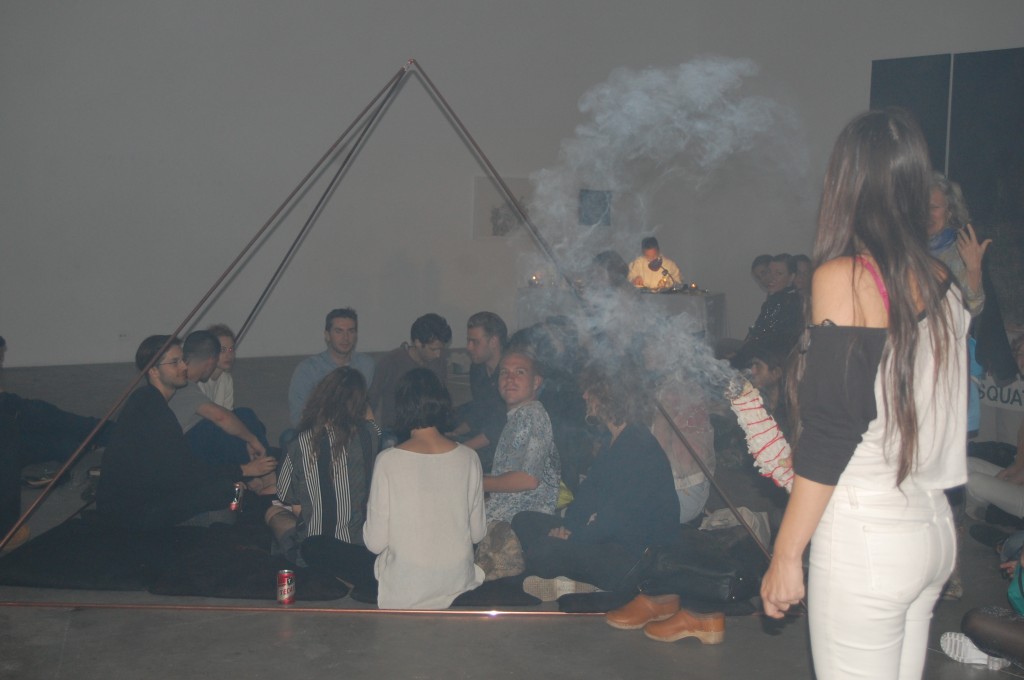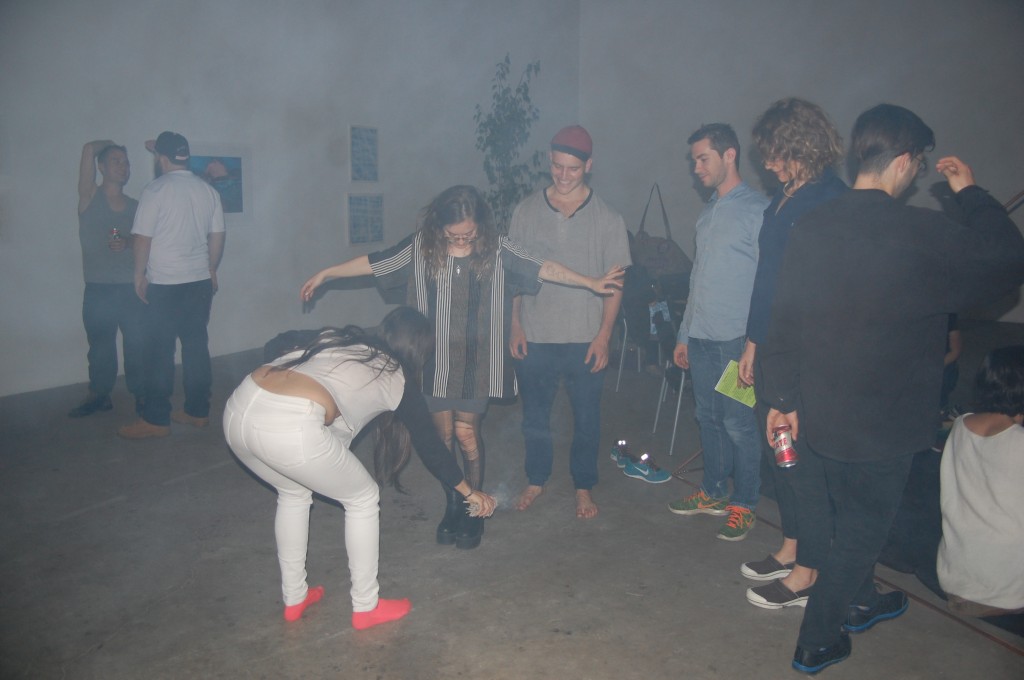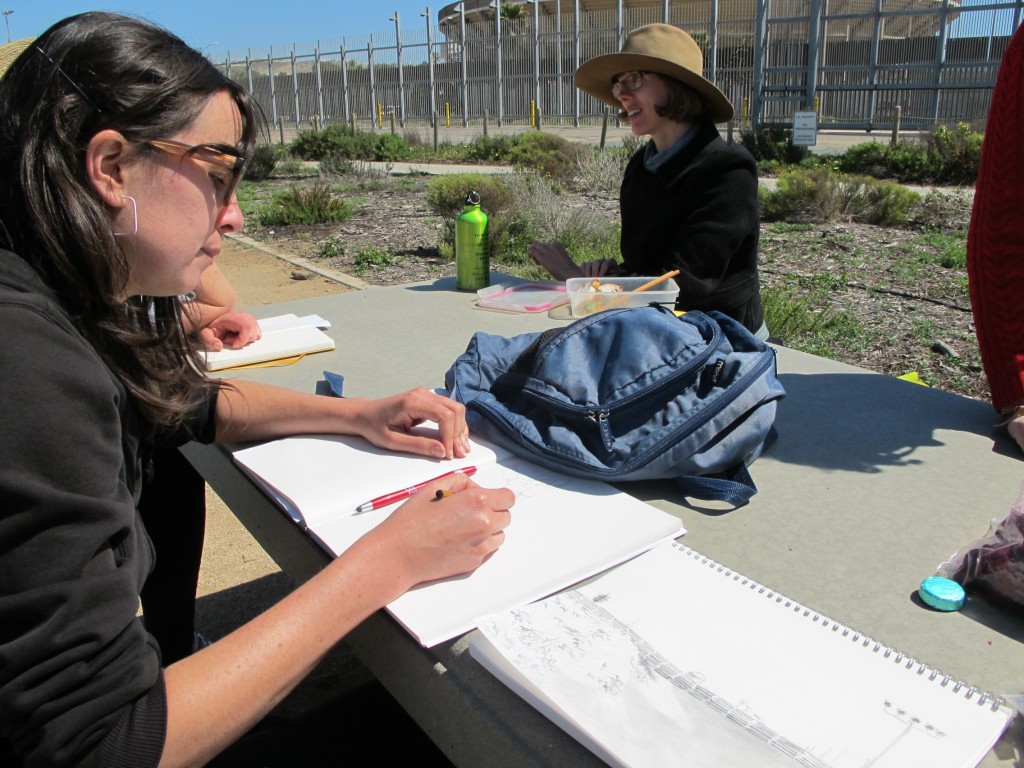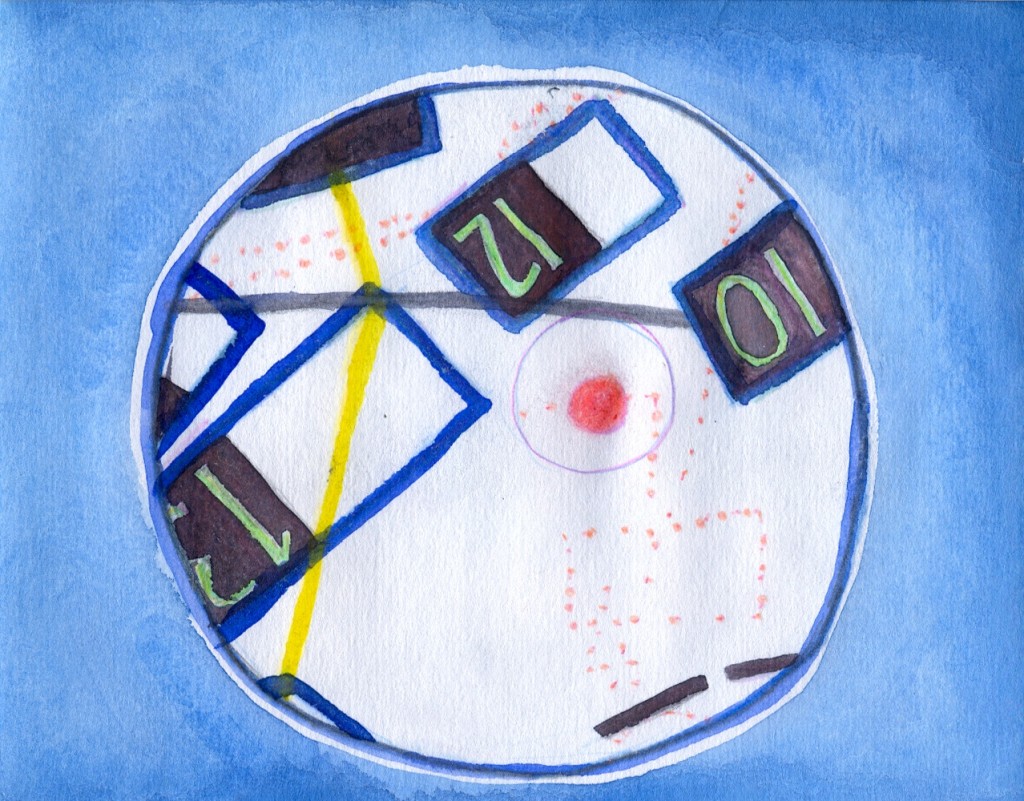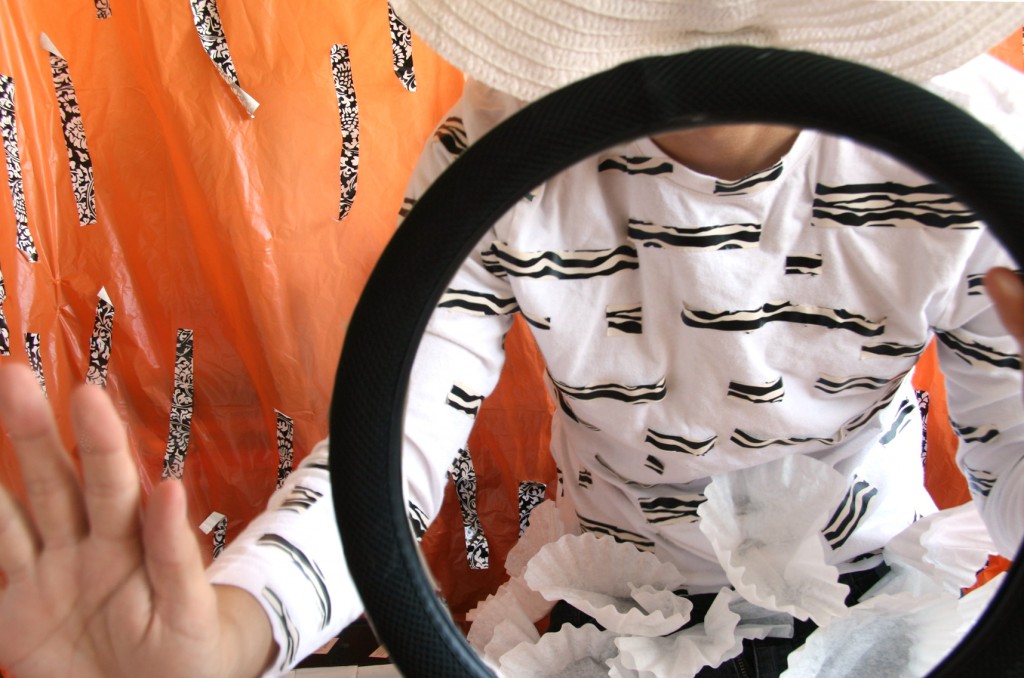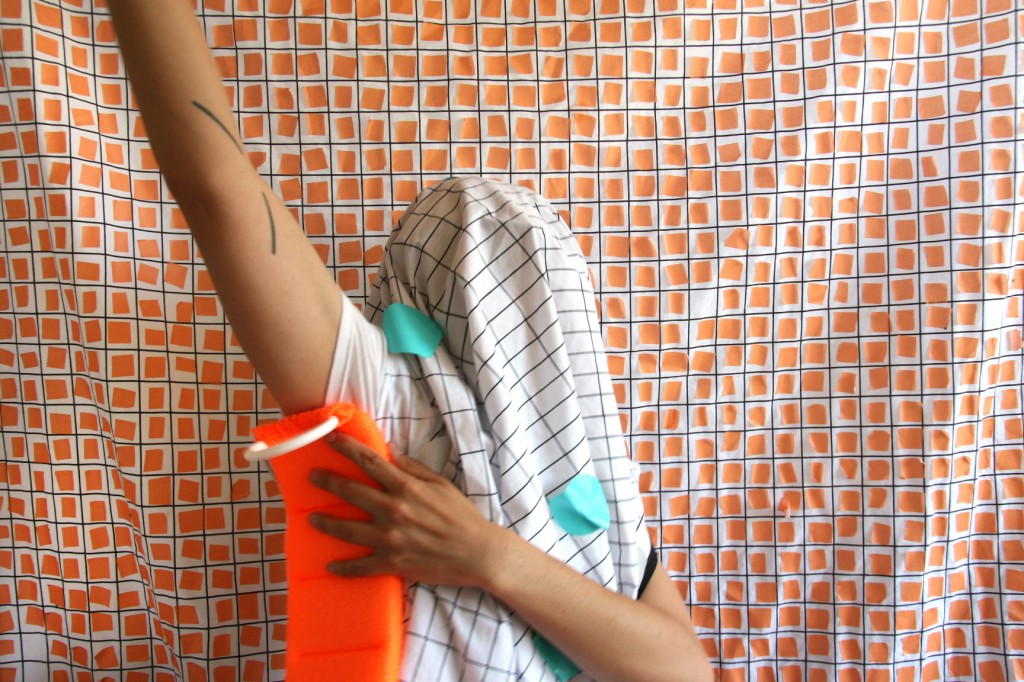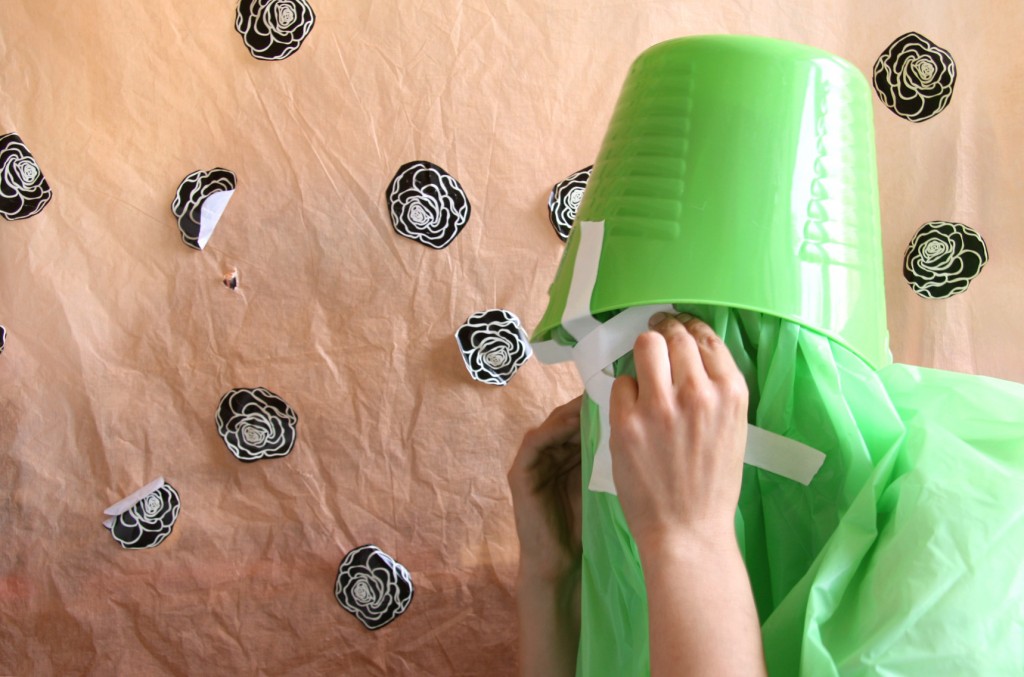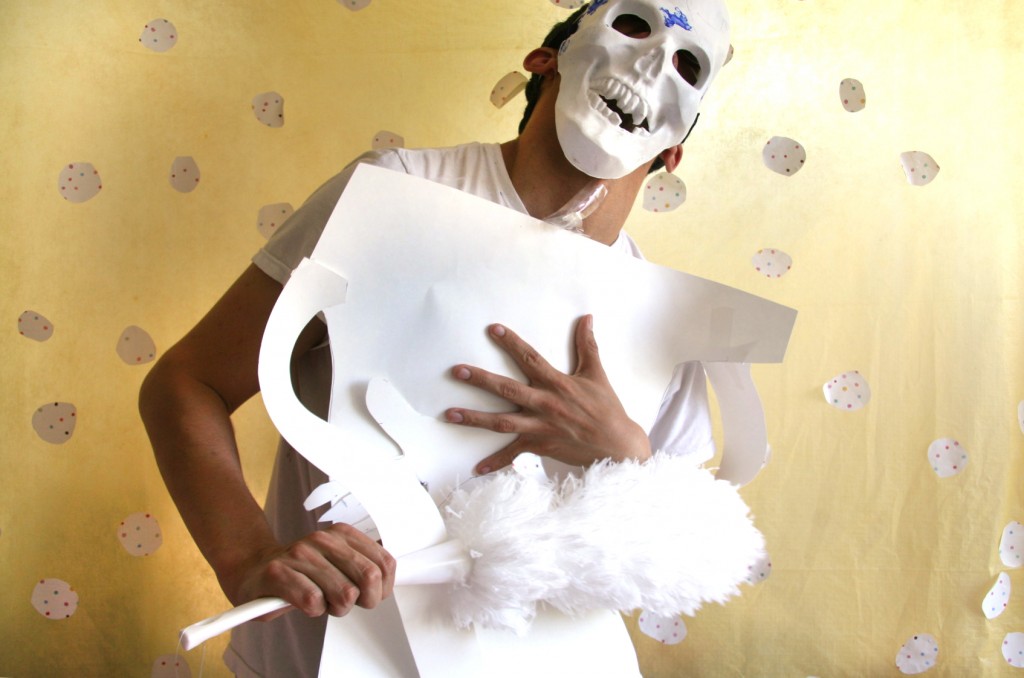Reflections on Rethink Environment
|
Featuring reflections by: Dan Bayles, Claudia Borgna, Kathy Garcia, Hillary Mushkin, Paul Pescador, Brianna Skellie and Boris Torres It has been almost three months since we physically joined together at HRLA to celebrate our community and reconsider the standing of our current political, social, and natural environments. The impact of the many readings, performances, teach-ins, and happenings that took place at Rethink Environment is only just now being felt and processed. In an attempt to keeping the energy of this gathering alive, here are is a collection of a few afterwords and thoughts about the art and events that we experienced that April weekend: Kathy Garcia Pyramid Meditation For RECAPS and Human Resources I constructed a 10ft x 10ft x 10ft pyramid and developed a very simple meditation that focused on the receiving centering and projecting of energy. The pyramid was set up to create a literal three-dimensional space that when entered set the stage for the participants to explore an interior-space. During a guided meditation using color, visualization, breathing and the perineum — a muscle located between the anus and the genitals — participants were instructed on how to receive energy from the earth, and then guided on how to release it from the base of the spine back into the ground and how to project it from the crown of the head outward. Inhale, receive/expand, center at the heart, exhale, release/project. The intention of the meditation was to facilitate a collective experience and to produce, through the use of applied, focused intention, a transfer of energy from the earth into the body, through a conduit (the pyramid) and back into the earth.
Dan Bayles Aerial Obscuration
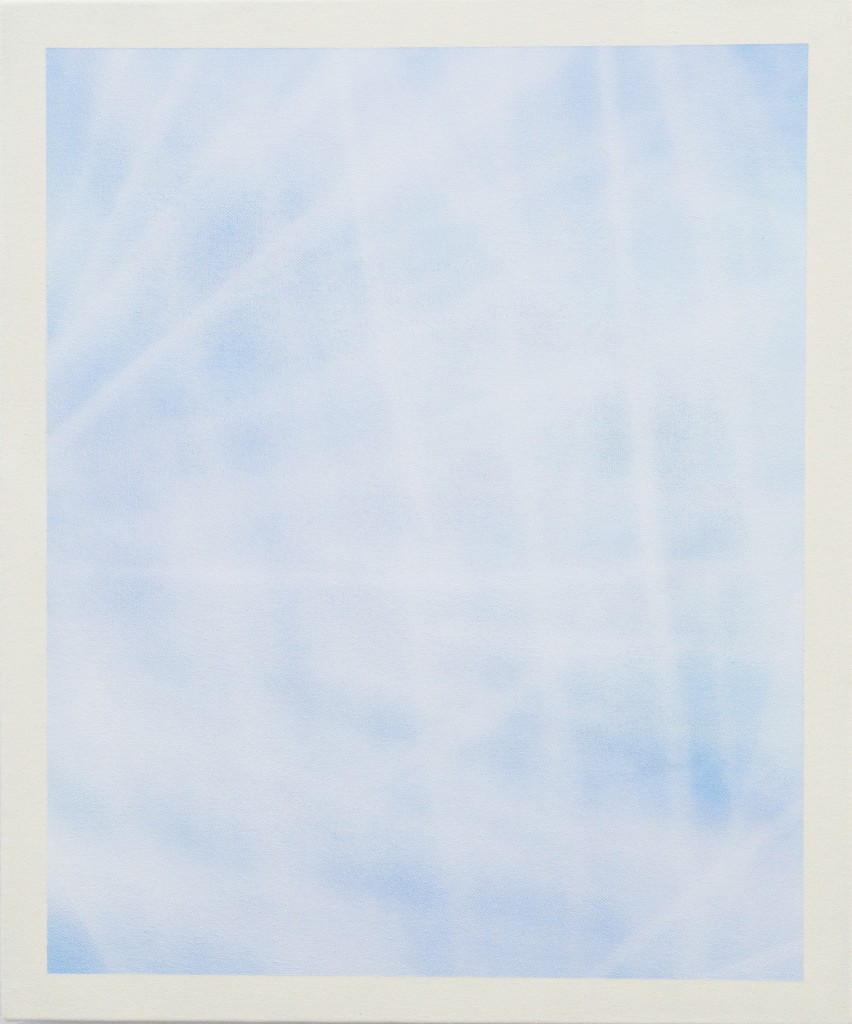 Aerial Obscuration #2, 2010 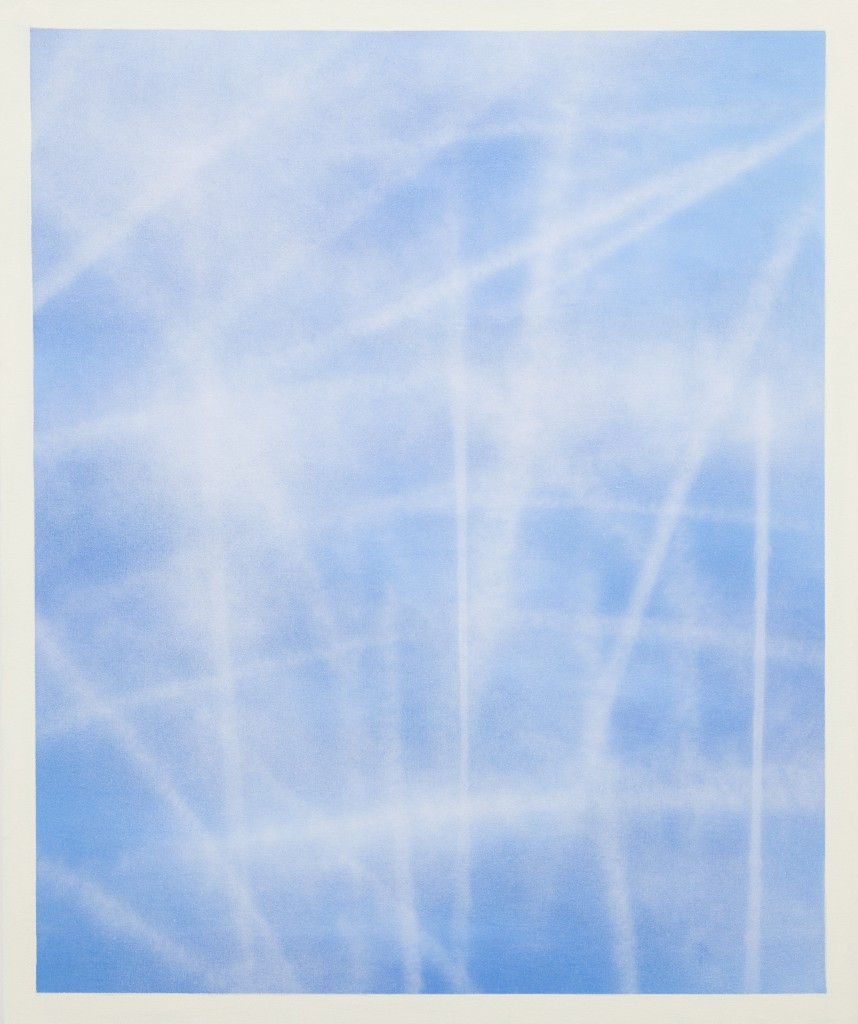 Aerial Obscuration #4, 2010 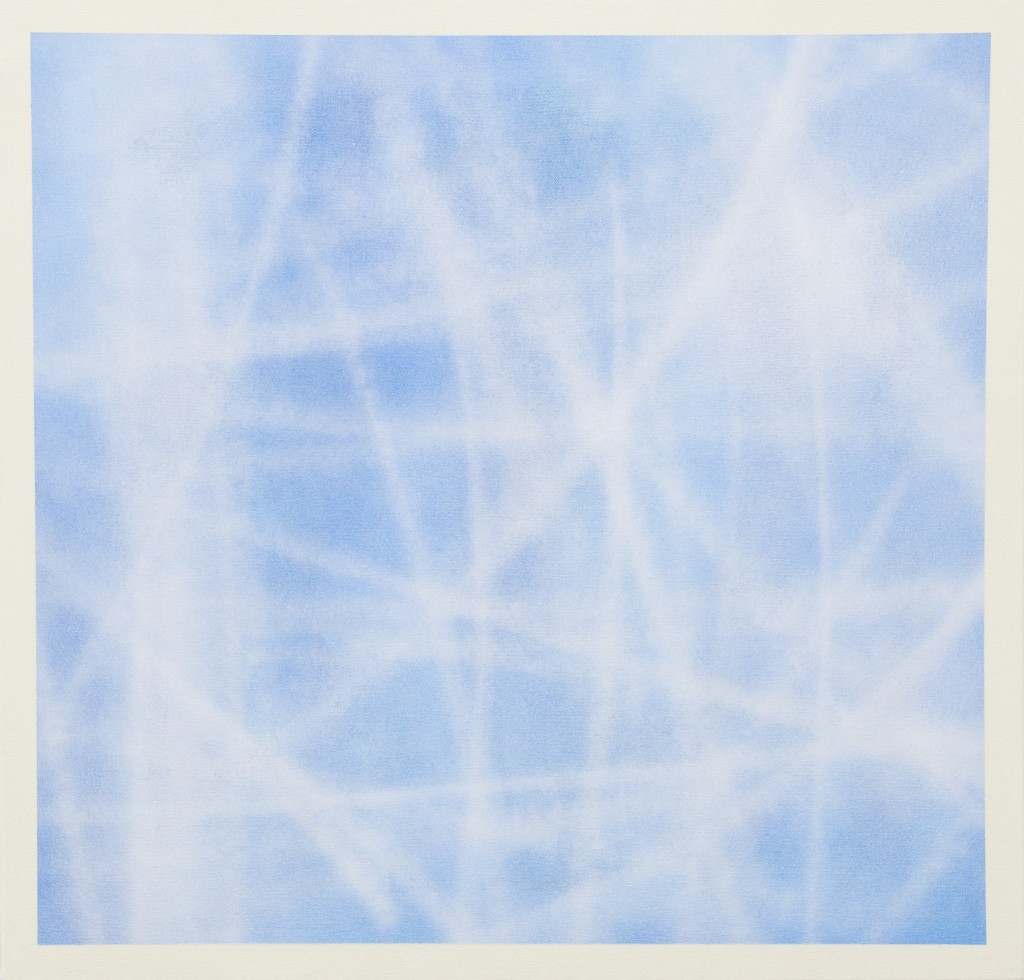 Aerial Obscuration #5, 2010 I see the Aerial Obscuration series as an extension of many past works dealing with architecture and landscape, particularly the American landscape. On a sunny day, in Los Angeles, in 2010, I began to drive from Cypress Park, where I lived at the time, to downtown and I noticed an unusual series on contrails across the sky. These lines crisscrossed over each other as if they were a skywriting exercise gone mad. In contrast to the blue sky, these sharp lines joined together to form an image from the ground that looked like a rhizome structure or an early grid painting made by Terry Winters. The artificiality of the view seemed overtly and absurdly man made, and didn’t seem to coincide with normal air traffic, though I could see the planes producing the man-made contrails. At the time, I couldn’t believe I seemed to be the only one noticing this (I expected everyone to be looking up in confused awe) but the world continued to go on without noticing. Throughout the day the grid hung in the air, unlike a normal contrail, which dissipates, turning what was a clear blue day into a hazy doldrum. I had heard about chem-trails and began to research the subject. Some further research, and more eye witnessing, has only made me wonder more about the possibilities of what is going on. Several U.S. patents have been given to technology which would allow for an airplane to release an aerosol mist in which aluminum bits reflect the sun’s rays away from the ground. There is a long history of experiments within the upper-atmosphere since the 60s, some of which have had negative consequences on human health and weather phenomena, which could account for the secrecy. There are many doomsday website explanations which seem unlikely, though there is definitely more going on than is being admitted to, which fuels the abundance of theories. While it is disturbing how much real information is kept from the public, it is interesting how myths can be created and fueled from that lack, and in that process an authentic cultural pulse can be taken by how the populous navigates fictional interpretation with factual revisionist history. Dan Bayles is an artist living in Los Angeles. He received is MFA from the University of California, Irvine . Images courtesy of Francois Ghebaly Gallery.
Claudia Borgna What do I really need to live?
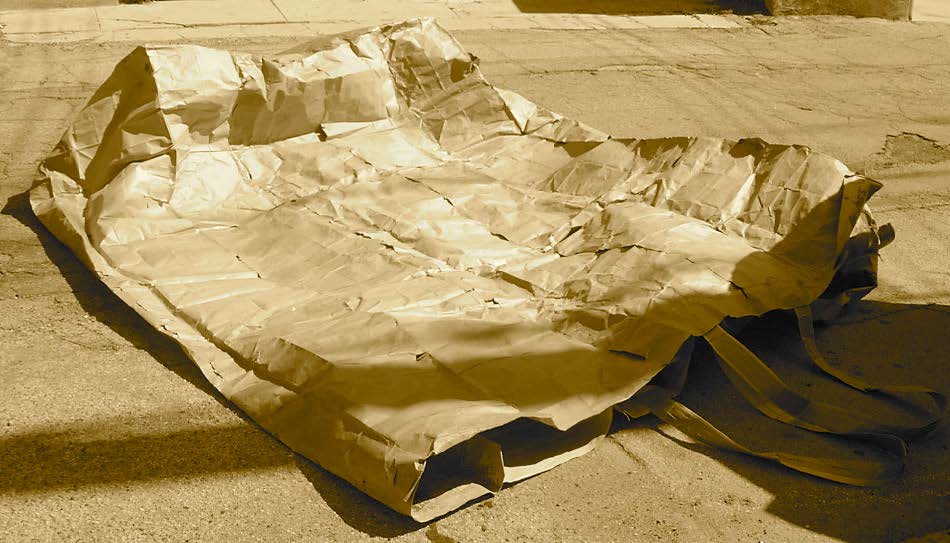 What do I really need to live?, 2014. 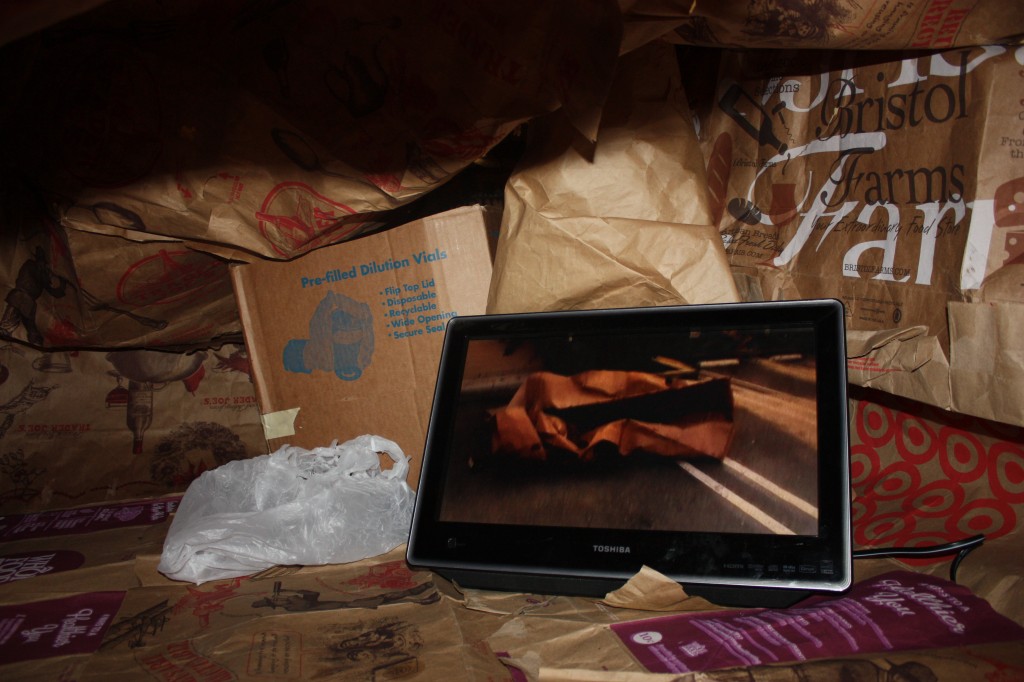 What do I really need to live?, 2014. What do I really need to live? What a stupid question, it’s so obvious, hey? No, what do I really need to live? A career, art? Yes, but what do I really, really need to live? Another war? Surely a shopping mall. At least, that’s what they say, what else will it be? Considered banal, everyday primary needs are humiliated, annihilated by the market. “Blame it on plastic bags!” Shouts the giant paper bag from inside the SUPER-market uttering GMO superiority while rising from the toxic ashes. The universe’s primordial rights to common good, like me, are choking in (commodified) thin air: Voosh, et voilà: abracadabra capitalist’s m(tr)agic! Sophistication or suffocation? (suffostication). Click boom ahhahh. A breath, a click and a bang: I am tired to live in this ‘breathtaking’ (western) culture (not) of mine. To view the video titled: ‘What do I really need to live?’ You’ll have to crawl inside a giant paper bag made out of many smaller and recycled grocery paper bags. This video-installation is an attempt to synchronize the audience’s breath with the artist’s anxieties and by so doing to share the experience of both suffocation and hyperventilation that comes with angst. At the core lies the intention to question the real necessities of life, of this world and of freedom. Claudia Borgna holds a BA in foreign literature from Genoa University and one in fine art from London Metropolitan University and is currently a public practice MFA 2015 candidate at Otis College of Art and Design in Los Angeles. While exhibiting internationally Claudia is a recipient of the Joan Mitchell, the Pollock-Krasner Grant, the Royal British Society of Sculptors Bursary Award as well as the Pritzker Foundation Endowed Fellowship Award. Short-listed for the BBC2 documentary: “School of Saatchi” and for the British Women Art Prize. Winner of the ‘Public Speaks’ Broomhill National Sculpture Prize 2010.
Hillary Mushkin Incendiary Traces: Investigating the Representation of Battlespaces
Incendiary Traces began in 2012-13 with a thematically linked series of outdoor drawing events and Artbound publications centered around four exemplary types of Southern California landscapes: urban, coastal, desert and international border. The events were held at militarized sites where participants could learn something new about picturing war from people who do this professionally. We are now embarking on a second series, building upon the insights gained from the first one. While the first series surveyed various types of landscapes in our region that serve as the backdrop for picturing war — in other words, where the military does this–in the coming months we’ll focus on the methods Southern California professionals use to visualize international conflict — that is, how the military does this. We will primarily expand upon the themes of technological viewing and lines of sight. Focusing on the “how,” this phase emphasizes critical observation and drawing on site as ways civilians, like the military, can palpably visualize war. The first articles in this series are now on KCET.org’s Artbound here: Incendiary Traces: Investigating the Representation of Battlespaces by Hillary Mushkin: http://www.kcet.org/arts/artbound/counties/incendiary-traces.html Crossing the Line: A History of Medical Inspection at the Border by Celeste Menchaca: http://www.kcet.org/arts/artbound/counties/san-diego/history-of-medical-inspection-at-the-border.html Artbound will publish new Incendiary Traces material every couple weeks throughout the next several months here: http://www.kcet.org/arts/artbound/projects/incendiary-traces/ Stay tuned, and contact Incendiary Traces at the project website or “like” it on Facebook for more information and upcoming events. http://www.incendiarytraces.org/ Hillary Mushkin is a visual artist exploring contemporary and historical intersections of visual culture and socio-political consciousness. She works in studio and post-studio forms including drawing, media, and interactive formats. Mushkin frequently collaborates with others from fields including art history, poetry, and architecture. Mushkin’s projects have been exhibited at the Freud Museum (London), the Getty Museum (Los Angeles), and White Columns (New York). She has also produced works in alternative contexts including sidewalks, a state park, and the 29 Palms Marine Corps base. In addition to her artistic practice, she is Co-Chair and Professor of Digital Media Arts and Design at Orange Coast College and Visiting Professor of Art and Design at California Institute of Technology (Caltech), directing a new art, design, science and engineering collaboration initiative. Mushkin received a BFA from Rhode Island School of Design and an MFA from U.C. Irvine.
Paul Pescador “Orange” or trying to write about being sick… I’m lying in bed instead of performing. In twenty minutes, I’m supposed to stand up on stage in a large room as an audience watches me stumble across the floor draped in orange fabric. Instead I’m fully dressed in jeans and button down, it’s the middle of the day and I’m sick. I like to say that I don’t get sick and when I do I’m resilient, yet as I lay here, I’m crumbling. I feel this weakness all along my body. I’m freezing, covered in three thick blankets even though its 80 degrees. I know it’s the flu, but I’m terrified its meningitis, as it’s been spreading across the gay club community resulting in the death of three men. I read over the symptoms: sore throat, headaches, feverish, stiff neck. My panic builds until I remember I never go out. I have been in and out of bed three times this month. This last time, I was in bed for 6 days unable to lift my head. I’m currently reading two books by Mark Doty. The first is memoir titled Heaven’s Coast, which is about the death of his long term partner from AIDS and the second Dog Years a memoir about the passing of his two dogs. Both are difficult reads and I tear up reading them, these painful details of loss and suffering as the author watches his loved one pass away. I remember the last time I went and got tested. I’m sitting in a waiting room in West Hollywood at a free clinic. I go alone and there are other young men waiting. Everyone looks so scared and withdrawn. The receptionist sits behind the counter watching an action film and I can hear the sounds of bullets coming from the TV. I see these young men go in and out to receive their test results and own fear increases when I’m called into the doctor’s office. This fear of getting infected travels with gay men and has stuck by my side since I was a child. I watch them as they draw blood, Carly Simon is on the radio and I sit and wait as they process my results. As a kid, I was terrified of diseases, mostly wide spread flesh eating viruses. I remember my dad reading me passages from The Hot Zone, a book which follows the history of the ebola virus. I remember the visceral deceptions and the manner in which the virus was passed between family members as they cleaned up their loved ones diarrhea and vomit. I’m listening to the news last week and a new case ebola recently broke out in Sierra Leone, over 121 of the 200 people who were infected died. I was also forced to watch the film Outbreak (1995), a fictional film which was roughly based upon The Hot Zone, I remember one of the first victims goes into a movie theater and coughing and spreading the virus to an unknown audience. I think about this scene sometimes when I’m at the movies. A few weeks ago, I’m sitting at lunch with a friend who tells me about some bio-chemical disease film with Gwyneth Paltrow. They talk about how viruses often spread through the touching of the eyes, mouth and nose. They lean into me as I shove a cookie in my mouth, “You have touched your face at least twenty times since we sat down.” I’m still in bed. In my mind, I’m performing “Orange” and I’m wearing a skeleton mask with my silhouette made out of white construction paper flopped onto my body. I attempt to perform sending out emails, sitting in traffic and taking out the dogs, these mundane acts which get heighten through pastel colored fabric polka dotted, contact paper, neon colored props. At some point the fabric I had attached on the wall no longer stay up and falls on to the floor. I try to reattach with packing tape but it won’t hold it. The masks I am wearing tilts so I can no longer see and I am stumbling along the stage shouting daily tasks as I am crashing into walls, breaking chairs and falling down steps. The audience begins laughing and clapping as I continue to shout through the thick plastic mask which makes my voice more and more muffled. Paul Pescador received his MFA in Visual Art from the University of California at Irvine in 2012. He is a visual artist and filmmaker, who occasionally writes about art, culture and film and his own personal experience to each. Brianna Skellie Rethinking Rewilding
The movement workshop I facilitated for the RECAPS event Rethink Environment at Human Resources LA was rooted in an interest of how we might move with our environment and the world, not just through it or in it. The title of the workshop was “Rewilding: a movement workshop towards the feral.” Rewilding is an argument in environmental conservation. George Monbiot writes, “rewilding, in my view, should involve reintroducing missing animals and plants, taking down the fences, blocking the drainage ditches, culling a few particularly invasive exotic species but otherwise standing back. It’s about abandoning the Biblical doctrine of dominion which has governed our relationship with the natural world” (1). In reading this, I was struck by how this concept can be applied as an approach to movement practices and deeper investigations of body and self. What arises when we step back? When we practice, do, move, but resist immediately naming, regulating, controlling and defining. Humans actively attempt to reduce risk, fear, and the unknown. I am interested in how not only exploring but also embracing our unknown internal and external experiences through movement practices might encourage wildness and expansive ways of being, in the instituted, physical, and imaginative. The workshop and subsequent reflection on it helped me articulate an ongoing inquiry in how movement practices might create or deepen connection with environment, self and other. I “think” environment quite often, it is a buzzword for daily human behavior and our relation to the world. Yet, when I “rethink environment” I am reminded how often the concept of environment I am most concerned with and come into contact with positions humans as in relation to, and not as integral part of environment. There is the inherent binary and separation of nature and human. Movement and the body is a rich site to explore and complicate binary ways of thinking and being. This exploration is not new or revelatory; many movement practitioners are passionate about and very good at disproving the Cartesian separation between mind and body. It is exploring binary and the ways we might experience being human in conjunction with environment and wildness that I find particularly interesting, as well as loaded. In relation to humans, wild quickly bring up histories and systems of power that have been concerned with defining what it means to BE human. Could pursuing movement practices of attuning and honing our relationship to environment and ecosystem develop a greater sensitivity to both environmental and social injustice and violence? I do not necessarily have movement practices in mind as I write this, but I think they would be a little wild and not systemic, hard to fix or define. Perhaps this is why I have found this reflection so difficult to write–the topic is something I am barely beginning to explore and resists clarity and explanation. As I have attempted to write about movement towards the feral I have found I have more questions to ask than information to articulate. How can rewilding inspire how humans think of and act in the world- just as we might speak of cultivating mindfulness, could we engage wildness to better understand and respect “environment?” Could this not only change how we move and exist in our human worlds, but also build a greater recognition and respect for that which is beyond human realm and control? My use of the term rewilding is an attempt to connect, engage, and fantasize across discipline and distinction. Movement towards the feral embraces wildness as well as a certain fantasy. It also resists definition and certitude. However, there is something there about shifting and moving. I notice a shift in awareness and consciousness through the embodied experiences of dancing and moving. I would like to believe movement practices that emphasize receptivity to the environment might shift how we function as individuals and parts in a larger ecosystem. References: http://www.monbiot.com/2013/05/27/a-manifesto-for-rewilding-the-world/ http://www.filmsforaction.org/watch/how-wolves-change-rivers/ Soule, Michael, and Noss, Reed. “Rewilding and Biodiversity.” Wild Earth. Fall, 1998. Brianna Skellie is a teacher, student, performer and choreographer. She is a founding member of SALTA, a collective of dancers who curate performance in Oakland, CA. SALTA, as a part of OMNIdance, will be opening a dance and performance space in Oakland in October, 2014. Brianna is currently pursuing her MFA in the Critical Dance Studies department at UC, Riverside.
Boris Torres New Work
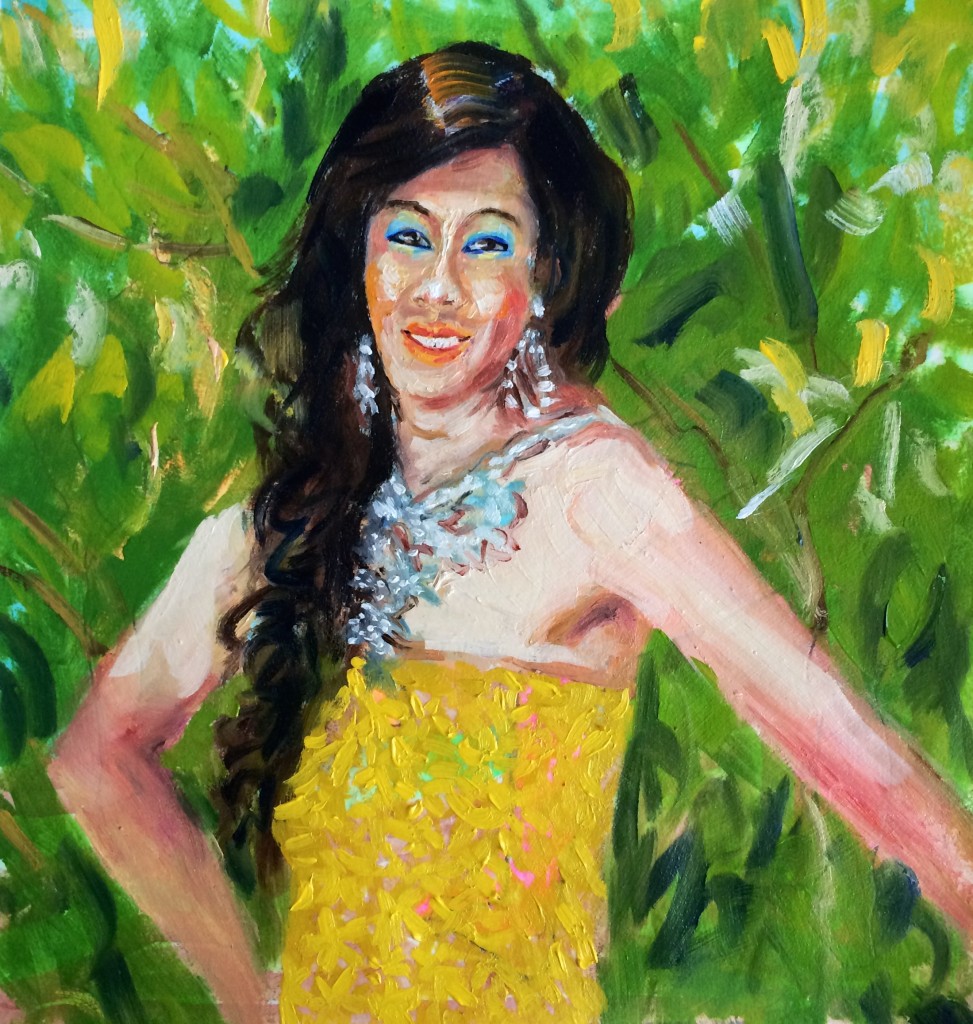 Alexia, oil on paper, 9×9 inches, 2014. 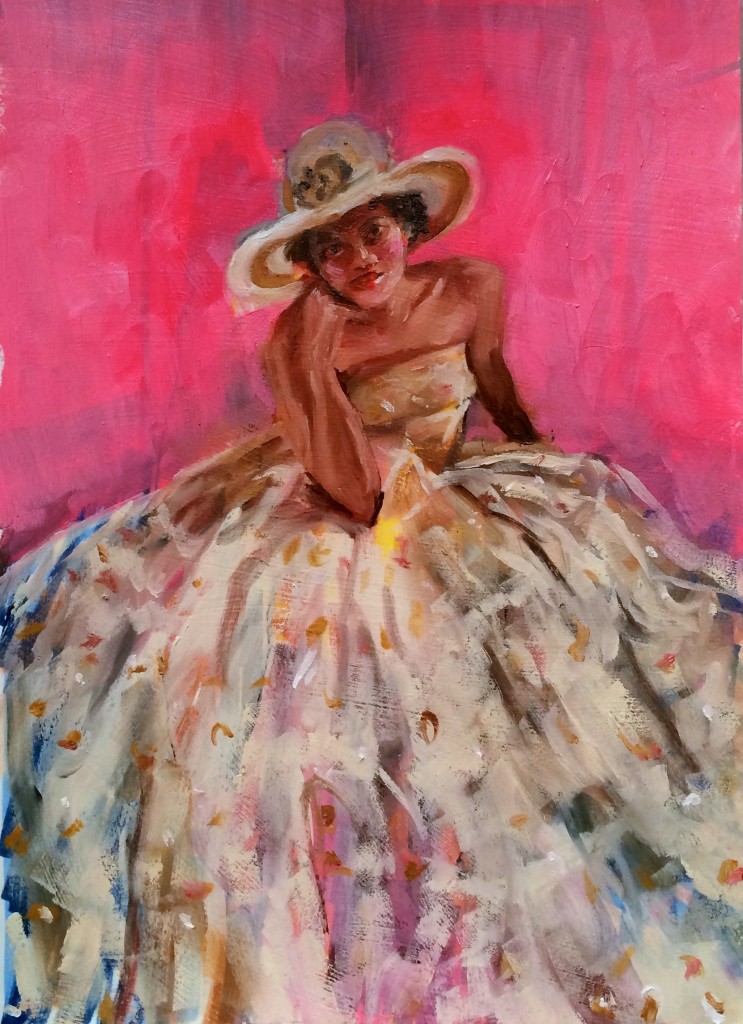 Jasmine, oil on paper, 9×12 inches, 2014. 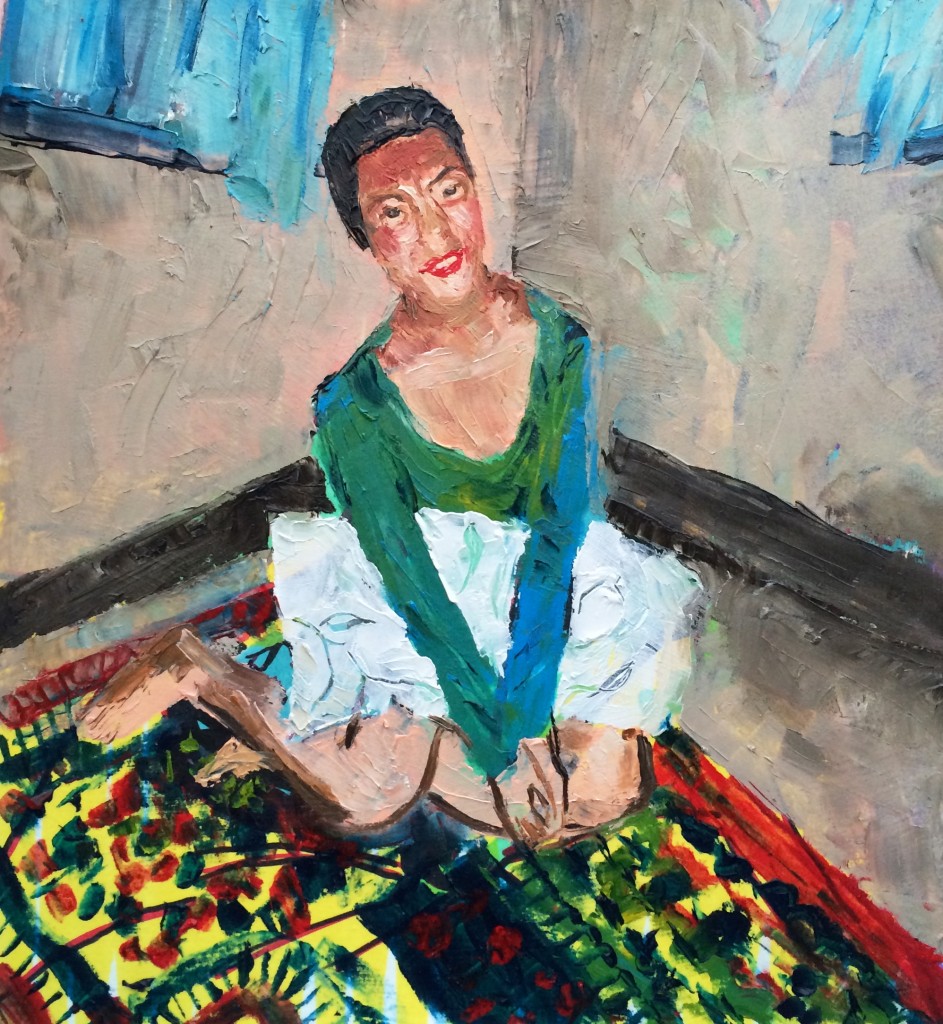 Mickie, oil on paper, 9×9 inches, 2014 Boris Torres is New York based artist, originally from Ecuador. His work has been exhibited internationally, at the Veneklasen/Werner Gallery in Berlin, La Petite Mort Gallery Gallery in Canada, La Naranjilla Mecánica in Quito, Ecuador, Bowman Bloom Gallery, Parlor Projects, Art in General, Center for Book Arts, LGBT Community Center, and Dumbo Arts Center in NYC. He received an MFA from Brooklyn College where he has also taught undergraduate painting.
|
